Home Tags Posts tagged with "pope john paul ii"
pope john paul ii
Mehmet Ali Agca, who shot and injured former Pope John Paul II in 1981, has laid flowers on the late pontiff’s tomb in the Vatican.
The 56-year-old Turkish man told police he felt he needed to make the gesture, Italian media report.
The gunman’s gesture comes 31 years to the day that Pope John Paul II visited Mehmet Ali Agca in prison and forgave him for the attempt on his life.
Mehmet Ali Agca served 19 years in an Italian jail for shooting the Pope twice at close range. His motive remains a mystery.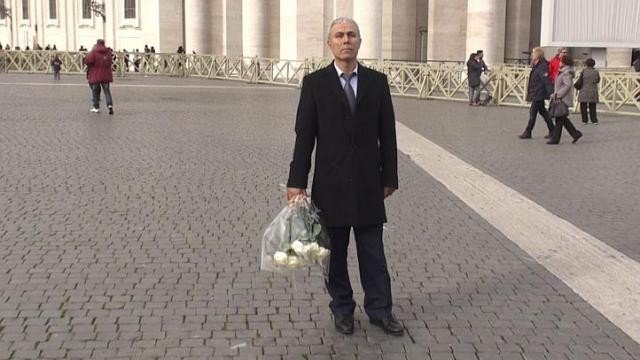
He spent another 10 years in prison in Turkey on charges related to the earlier murder of a newspaper editor.
Mehmet Ali Agca laid white roses at the tomb of the late Pope on December 27, in his first visit to the Vatican since his attack on John Paul II on May 13, 1981.
Pope John Paul II was left seriously injured, with one bullet passing through his abdomen and another narrowly missing his heart.
Vatican officials have for a second time denied Mehmet Ali Agca’s request for a face-to-face meeting with Pope Francis.
“He has put flowers on the tomb of John Paul II. I think that is enough,” the Vatican spokesman, Father Federico Lombardi, told La Repubblica newspaper.
[youtube i5vWEWiVmhY 650]
Pope Francis has declared Popes John Paul II and John XXIII saints in a ceremony attended by hundreds of thousands of people in St. Peter Square.
Pope Francis praised his two predecessors as “men of courage” at the Vatican service, the first time in history that two popes have been canonized at the same time.
The Mass was attended by Pope Emeritus Benedict, who quit as pope last year, and roughly 100 foreign delegations.
Analysts say Pope Francis is trying to balance the conservative legacy of John Paul with the reforming zeal of John.
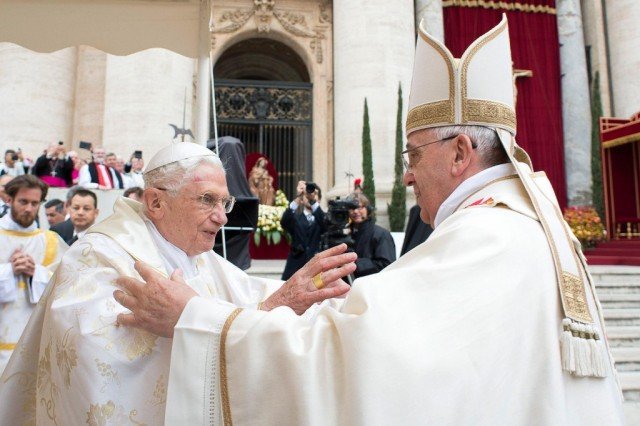
Pope Emeritus Benedict XVI and Pope Francis during Mass before the canonization ceremony of Popes John XXIII and John Paul II
At the climax of the service, Pope Francis said in Latin: “We declare and define Blessed John XXIII and John Paul II to be saints and we enroll them among the saints, decreeing that they are to be venerated as such by the whole Church.”
Relics of each man – a container of blood from John Paul and a piece of skin from John – were placed near the altar.
Pope Francis paid tribute to the two new saints as “priests, bishops and popes of the 20th Century”.
“They lived through the tragic events of that century, but they were not overwhelmed by them. For them, God was more powerful,” he said.
The Vatican estimated some 800,000 pilgrims had poured into Rome to see the two-hour ceremony first-hand.
For those unable to make it into St Peter’s Square, giant screens were set up in nearby streets and elsewhere in the city.
[youtube QxwlQSrmIwM 650]
Pope John Paul II and Pope John XXIII’s canonization is bringing attention to the complex process of becoming a saint, a highly regulated series of steps that can seem quite mysterious to those who are not devout Roman Catholics.
How many saints are there?
It’s hard to pin down an exact number, but more than you might think. In the old days – as in the first thousand years of the church’s history – saints were created by popular demand.
St. Ulrich of Augsburg was the first to be canonized by a pope, in 993, and the Vatican eventually took over and formalized the process.
The Vatican’s Roman Martyrology says some 7,000 people have been canonized or beatified (an earlier step), but some scholars believe the total number of saints is more like 10,000.
Is it easier or harder to become a saint now?
The raw numbers would suggest it’s easier, though they don’t tell the entire story.
Pope Francis, who has been pontiff for just over a year, has already canonized 817 men and women, but 813 of them were martyrs from a single group of Italians who were beheaded by Ottoman Turks in the 15th Century.

Pope John Paul II and Pope John XXIII’s canonization is bringing attention to the complex process of becoming a saint
John Paul II canonized 482 during the quarter-century he presided over the church, but more than 400 of those were from groups of martyrs, according to the Catholic World Report.
By contrast, Pope Benedict XVI added 45 saints during his pontificate.
Does every pope become a saint?
Yet, only about a third of all popes are saints, and it’s getting harder to make the leap the from St. Peter’s throne to sainthood, according to the Pew Research Center.
Fifty-two of the first 55 popes got the nod but that pace has slowed dramatically. Only five popes have become saints in the last 1,000 years, although that will now shoot up to seven. Four more popes who died between 1878 and 1978 are in the pipeline – Pius IX, Pius XII, Paul VI, and John Paul I – but John Paul II leapfrogged ahead of them.
Can sainthood be revoked?
Canonization is permanent but some saints have been, for lack of a better term, demoted – by being dropped from the Vatican’s list of official feast days, sometimes because of questions about whether they actually existed.
One notable example is Saint Philomena, who was recognized in 1835 after a tomb with a remains of a teenage girl was found in the Roman catacombs with the inscription “Filumena” and a symbol of martydom, according to the Times of London.
The Vatican suppressed her cult in 1960 after experts decided there was no evidence linking the bones in the tomb to the legend of a martyred Greek princess.
Saint Christopher, the patron of travelers, lost his standing in 1969 – although not his popular cachet if the number of medals hanging from rear-view mirrors in cars is any indication. St. George, the patron of warriors, was also bumped down that year but restored in 2001 without explanation.
Where can I find a list of all the saints?
The compendiums that exist are extensive, but not necessarily exhaustive. And you might want to brush up on your Latin.
The Vatican’s Congregation for the Causes of Saints, the bureaucratic arm of the church that shepherds candidates through the complex steps, published the Index ac Status Causarum in 1998 with the names of the blesseds and saints – but only for the previous 400 years.
An oft-cited reference is Butler’s Lives of the Saints, but that was written in the mid-18th century and only contains 2,500 biographies in its latest revision.
Then there is the Acta Santorum, an index based on feast days that has 68 volumes, the first of which was published in 1643. A cluster of scholarly Jesuit priests in Brussels, the Bollandists, is toiling to complete it in chronological order, using church records and old texts in myriad languages to verify that the saints deserve veneration.
Pope John Paul II and Pope John XXIII are to be declared saints at an unprecedented open-air ceremony in Rome on Sunday.
A Mass co-celebrated by Pope Francis and his predecessor, Pope Emeritus Benedict, will be witnessed by one million pilgrims and a vast TV and radio audience.
Nearly 100 foreign delegations are due, including royal dignitaries and heads of state and government.
It is the first time two popes have been canonized at the same time.
Correspondents say the move is being seen as an attempt to unite conservative and reformist camps within the Roman Catholic Church.
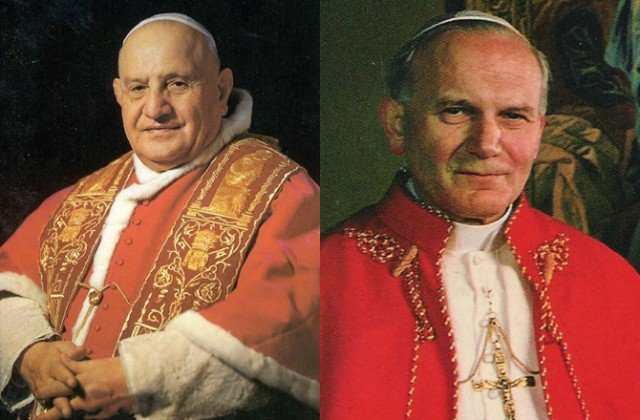
Pope John Paul II and Pope John XXIII are to be declared saints at an unprecedented open-air ceremony in Rome
Pilgrims have been pouring into Rome and special bus, train and boat services ferried many more into the city early on Sunday morning for the two-hour ceremony which starts at 10:00 local.
Some had bagged places to sleep overnight as close as possible to St Peter’s Square, hoping to be among the first in when it opens to the public.
Giant screens have also been erected in nearby streets and elsewhere in the city for those unable to get into the square.
The Vatican confirmed on Saturday that 87-year-old Pope Emeritus Benedict XVI would make a rare public appearance alongside his successor, Pope Francis.
“He will co-celebrate, which does not mean he will go to the altar,” a Vatican spokesman said.
“We will all be happy to have him there.”
Benedict XVI became the first pope to resign for 600 years when he quit for health reasons a year ago, sending shock waves around the world.
The process of saint-making is usually long and very costly.
However, John Paul II, whose 26-year reign ended in 2005, has been fast-tracked to sainthood in just nine years.
Many among the huge crowds that gathered as he lay dying cried out “Santo subito!” (Make him a saint immediately!).
By contrast Italian-born John XXIII, known as the Good Pope after his 1958-1963 papacy, had his promotion to full sainthood decided suddenly and very recently by Pope Francis.
By canonizing both John XXIII – the pope who set off the reform movement – and John Paul II – the pope who applied the brakes – Pope Francis has skillfully deflected any possible criticism that he could be taking sides.
[youtube tdCx0oB-CLo 650]
A man has died in northern Italy after being crushed by a crucifix erected in honor of Pope John Paul II.
Marco Gusmini, 21, was killed instantly and one other man taken to hospital, Italian media reported.
Part of the 100ft-high sculpture collapsed at a ceremony ahead of the Pope’s canonization.
Pope John Paul II and his predecessor, Pope John XXIII, are due to be declared saints on Sunday.
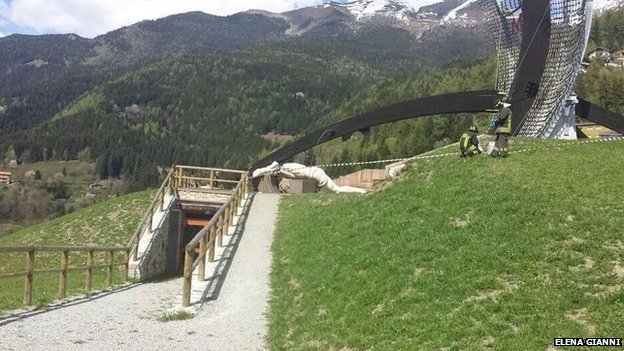
Pope John Paul II crucifix in Cevo commemorates the pontiff’s visit to the area in 1998 (photo Elena Gianni)
The crucifix commemorates the Pope’s visit to the area in 1998.
The installation, near the town of Cevo, was designed as a large curved cross with a statue of Jesus Christ, weighing 1,320lb, fixed to the top.
A group of children were reported to be in attendance at the time.
The cross was designed by sculptor Enrico Job and was created for John Paul II’s visit to nearby Brescia.
The two popes will be declared saints at the Vatican on Sunday.
It is not the first death caused by a falling crucifix in Italy.
In 2004, the Associated Press reported that a 72-year old woman had been crushed to death by a 7ft-tall metal crucifix in the town of Sant’Onofrio in the south of Italy.
Italian police recovered a stolen gold and glass case that once contained the blood of the late Pope John Paul II, only to find the cloth stained with the blood itself was missing, officials said.
Pasquale Corriere, head of the association that looks after the small church in the mountains east of Rome from which the reliquary was stolen, said two men had been detained by police in the regional capital, L’Aquila.
The men took the police to the site where they had dumped the reliquary, but the cloth stained with the blood of the pope, who died in 2005, was no longer inside, Pasquale Corriere said.

Italian police recovered a stolen gold and glass case that once contained the blood of the late Pope John Paul II
Police were interrogating the men, who they believed to be drug addicts, and searching their apartment, Pasquale Corriere said. A small crucifix stolen along with the reliquary from the church of San Pietro della Ienca last weekend was also recovered.
The blood-soaked cloth was a fragment of the cassock that John Paul was wearing on May 13, 1981, when he was shot in an assassination attempt.
Relics of saints and other holy figures are often displayed in reliquaries to be venerated by the Catholic faithful.
The late pope, who is due to be declared a saint on April 27, loved the mountains in the Abruzzo region because they reminded him of those in his native Poland, and he would slip away secretly from the pressures of the Vatican to hike and ski there in the early years of his papacy.
[youtube 8tsXcHtU_zs 650]
Dozens of Italian police officers are hunting for a stolen holy relic that contains the blood of Pope John Paul ll.
It appears to have been taken during the burglary of a small chapel that was a place of special significance to Pope John Paul II.
The church of San Pietro della Ienca lies in an isolated spot in the mountains of central Abruzzo region.
Over the weekend, thieves broke some protective iron bars and forced their way in through a window.
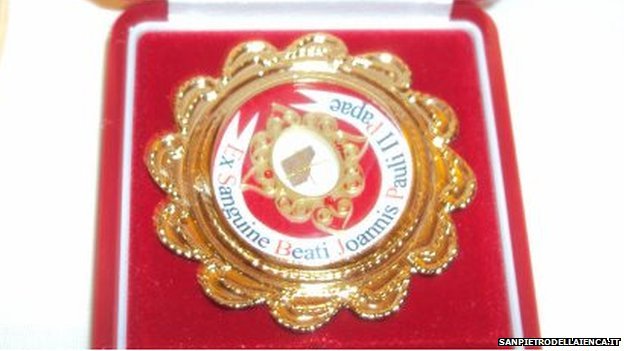
The stolen holy relic contains the blood of Pope John Paul ll
They left the collection box, but took a crucifix and the priceless relic, which contains a piece of gauze once soaked in the blood of the late Pope – one of only three such relics in the world.
Members of the local cultural association supporting the chapel are distraught.
Pope John Paul II used to escape the pressures of life in the Vatican by coming to the mountains.
Dozens of police officers are now searching the area with sniffer dogs.
Pope Francis has announced that Pope John Paul II and Pope John XXIII will be declared saints on April 27, 2014.
The pontiff said in July that he would canonize his two predecessors, after approving a second miracle attributed to John Paul.
Polish John Paul, the first non-Italian pope for more than 400 years, led the Catholic Church from 1978 to 2005.
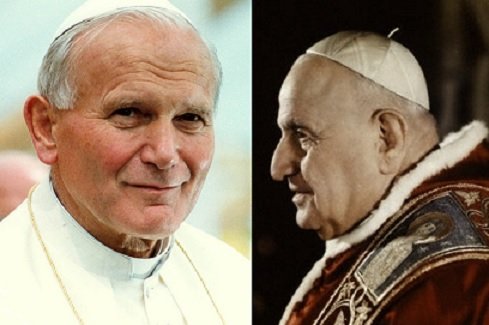
Pope John Paul II and Pope John XXIII will be declared saints on April 27, 2014
Pope John XXIII was pontiff from 1958 to 1963, calling the Second Vatican Council that transformed the Church.
The decision to canonize the two popes at the same time appears designed to unify Catholics, correspondents say.
Pope John Paul II is a favorite of conservative Catholics, while Pope John XXIII is widely admired by the Church’s progressive wing.
John Paul stood out for his media-friendly, globetrotting style. He was a fierce critic of both communism and what he saw as the excesses of capitalism.
Pope John is remembered for introducing the vernacular to replace Latin in church masses and for creating warmer ties between the Catholic Church and the Jewish faith.
Pope John XXIII has a big following in Italy, where he is known as Il Papa Buono, the good pope.
[youtube KszLw5r9LbA]
A giant statue of Pope John Paul II is to be unveiled on a hill above the city of Czestochowa in southern Poland.
The statue is said to be the tallest of the former pontiff anywhere in the world.
Weighing five tonnes, the 13.8 m (45-ft) white fibreglass statue shows Pope John Paul II standing with outstretched arms.
Czestochowa is home to the country’s most important pilgrimage site, the Jasna Gora monastery, and its icon of the Black Madonna.
A choir, an archbishop and an actor who will read from selected texts written by the Polish pope, are scheduled to take part in Saturday’s unveiling ceremony.
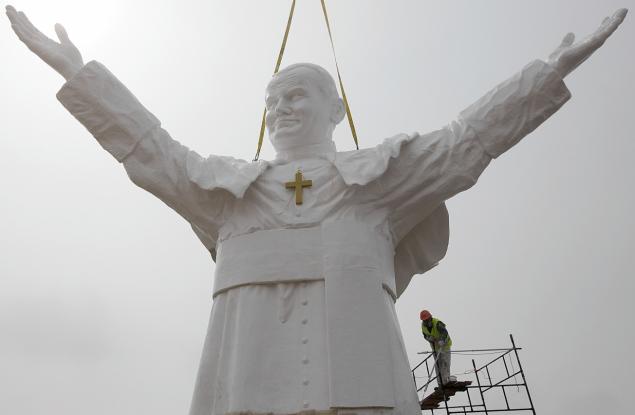
A giant statue of Pope John Paul II is to be unveiled on a hill above the city of Czestochowa in southern Poland.
Constructed around a steel framework, the statue has been built by a company that manufactures fibreglass statues such as ones of dinosaurs seen in theme parks.
The man funding the project, Leszek Lyson, said he wanted to give thanks to John Paul II for the life of his son, whom Lyson saved from drowning during a family holiday in Croatia three years ago.
Poland is one of the most Roman Catholic countries in Europe but the statue has not won universal acclaim.
A protest campaign has been launched on Facebook because the pope is facing away from the city.
And Czestochowa’s architects’ association says the fibreglass structure lacks quality.
Born Karol Wojtyla in Wadowice, the 58-year-old Archbishop of Krakow’s election as pope in 1978 stunned the Catholic world.
The first non-Italian pope in more than 450 years, Pope John Paul II went on to become one of the most familiar faces in the world, visiting more than 120 countries in a 27-year pontificate that earned him a reputation as an international fighter for freedom.
Pope John Paul II died aged 84 in 2005 after a long illness. He was beatified – the penultimate step towards sainthood – in 2011.
[youtube TEVoD_22EGc]
More than 100 cardinals of the Roman Catholic Church have gathered to Vatican for a new pope election. At some point, white smoke billowing from the Sistine Chapel will show that a decision has been made.
What goes on behind the closed doors before the smoke appears?
Here are 10 lesser-known facts about the papal conclave.
1. It’s a lock-in. Conclave comes from the Latin “cum-clave” meaning literally “with key” – the cardinal-electors will be locked in the Sistine Chapel each day until Benedict XVI’s successor is chosen. The tradition dates back to 1268, when after nearly three years of deliberation the cardinals had still not agreed on a new pope, prompting the people of Rome to hurry things up by locking them up and cutting their rations. Duly elected, the new pope, Gregory X, ruled that in future cardinals should be sequestered from the start of the conclave.
2. Spying is tricky. During the conclave they are allowed no contact with the outside the world – no papers, no TV, no phones, no Twitter. And the world is allowed no contact with them. The threat of excommunication hangs over any cardinal who breaks the rules.
Before the conclave starts, the Sistine Chapel is swept for recording equipment and hidden cameras. It is a myth that a fake floor is laid to cater for anti-bugging devices… Anti-bugging devices are used, and the floor is raised, but only to protect the marble mosaic floor.
3. Portable loos play an essential role. Until 2005, the cardinals endured Spartan conditions in makeshift “cells” close to the Sistine Chapel. They slept on hard beds and were issued with chamber pots. Pope John Paul II changed that with the construction of a five-storey 130-room guest house near St Peter’s – Domus Sanctae Marthae (St Martha’s House). But cardinals still have to rough it while voting. In an interview with the Catholic News Service last week, Antonio Paolucci, the director of the Vatican Museum said: “I believe they may be installing portable chemical toilets inside the chapel.”
4. An “interregnum” is ending. The pontificate used to be known as a “reign” – hence the period between two popes being called an interregnum (“between reigns”). Many of the regal trappings of the papacy were set aside by Pope Paul VI, who began his pontificate in 1963 with a coronation, but never wore the beehive-shaped papal tiara again.

More than 100 cardinals of the Roman Catholic Church have gathered to Vatican for a new pope election
5. Counted votes are sewn up. The cardinals hold one vote on day one and then two each morning and afternoon until a candidate wins a two-thirds majority. Each writes his choice on a slip of paper, in disguised handwriting, and folds it in half. Cardinals then process to the altar one by one and place the ballots in an urn. The papers are mixed, counted, opened and scrutinized by three cardinals, the third of whom passes a needle and thread through the counted votes. At the end of each morning and afternoon session the papers are burned.
6. Chemicals color the smoke. Those 115 ballot papers produce an unusual amount of smoke… which pours out of a chimney specially installed on the roof of the Sistine Chapel. A chemical is mixed with the paper to produce black smoke when voting is inconclusive, or white smoke when a pope has been elected. But even the white smoke looks dark against a bright sky, so to avoid any possible confusion, white smoke is accompanied by the pealing of bells. In 2005, though, the official responsible for authorizing the bells was temporarily occupied with other duties, so there was a period of confusion while white smoke billowed out, and the bells of St Peter’s remained silent.
7. Robes are prepared in S, M and L. The Pope has to look the part when he is presented to the faithful from a balcony overlooking St Peter’s Square. So papal tailors Gammarelli prepare three sets of vestments – in small, medium and large sizes. These will include a white cassock, a white silk sash, a white zucchetto (skullcap), red leather shoes and a red velvet mozzetta or capelet with ermine trim – a style revived by Benedict XVI. The Pope dresses by himself, donning a gold-corded pectoral cross and a red embroidered stole. (Popes traditionally wore red, but in 1566 St Pius V, a Dominican, decided to continue wearing his white robes. Only the Pope’s red mozzetta, capelet and shoes remain from the pre-1566 days.)
8. Huge bets are laid. Experts suggest more than $15 million will be wagered as people guess which cardinal will get the nod – making this the world’s most bet-upon non-sporting event. It’s not a new phenomenon. In 1503 betting on the pope was already referred to as “an old practice”. Pope Gregory XIV was so cheesed off that in 1591 he threatened punters with excommunication, but the gambling continues unabated. Prominent Italian and Latin American names currently lead the field.
9. Just say yes. Technically, an elected Pope can refuse to take up the position, but it’s not really done to turn down the Holy Spirit. That said, few relish the prospect of leading the world’s largest Church, beset as it is at the moment with falling congregation numbers, sex abuse scandals and internal wrangling. So many new popes are overcome with emotion after their election that the first room they enter, to dress for the balcony scene, is commonly known as the Room of Tears.
10. There is no gender test. Chairs with a large hole cut in the seat are sometimes thought to have been used to check the sex of a new Pope. The story goes that the aim of the checks was to prevent a repeat of the scandal of “Pope Joan”, a legendary female cardinal supposedly elected pope in the 14th Century. Most historians agree that the Joan story is nonsense. Examples of the chairs, the sedes stercoraria, are apparently held in museums, but their purpose is unclear. One unconfirmed theory is that they were used to check that the new pope had not been castrated.
[youtube xUtj8nd_pl4]










